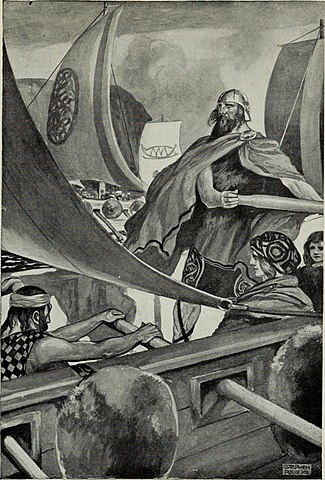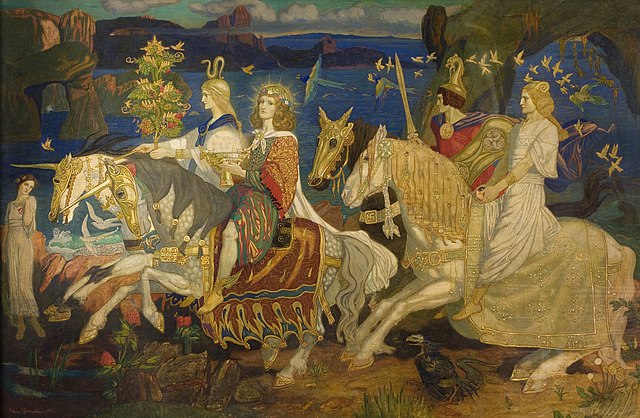The Milesians: Exploring Ireland’s Mythical Origin Story
The Milesian
Have you ever wondered where the ancient Irish Gaels traced their ancestry in medieval legends? One of the most famous origin stories is that of the Milesians, a group who, according to Irish myths, sailed to Ireland and became the ancestors of the modern Irish people. These tales come from medieval writings known as the Lebor Gabála Érenn (or The Book of Invasions). In this blog post, we will explore who the Milesians were, why they travelled to Ireland, and the significance of their story in Irish culture.
Table of Contents
Who Were the Milesians?
Meaning of the Name
The name “Milesians” comes from the Irish term Míl Espáine, which means “Soldier of Spain.” In the legends, these people were said to have arrived from the Iberian Peninsula—referred to in medieval times simply as “Spain.” The use of Spain here does not strictly match the modern-day nation-state. Still, it reflects how medieval Irish storytellers imagined far-off lands.
Mythical Origins
In some versions of the story, the Milesians’ ancestors supposedly came from places as distant as Scythia (near the Black Sea) or Egypt. Medieval Irish writers were eager to connect Ireland’s origins to the wider world, including biblical and classical civilisations. These older traditions mix history with myth, giving us a vivid but not strictly factual picture of where the Irish believed they came from.
The Journey to Ireland
Prophecy and Exploration

The Milesians’ journey begins with a man called Íth. Íth’s story is a pivotal episode in the medieval Irish text known as the Lebor Gabála Érenn (The Book of Invasions). He is portrayed as an adventurous figure who first glimpses Ireland’s distant coastline from a tall tower in Brigantia, located northwest of the Iberian Peninsula. Drawn by the island’s mysterious beauty, Íth becomes determined to see this unknown land himself.
Upon arriving in Ireland with a small group, Íth initially experiences a warm welcome from some local rulers, often described in the legends as three kings: Mac Cuill, Mac Cécht, and Mac Gréine. He quickly grows enchanted by Ireland’s lush landscapes and abundant resources. In conversations with these rulers, Íth openly praises the land’s potential, speaking of its richness and how it could provide prosperity for its inhabitants.
However, this admiration for Ireland does not sit well with everyone. Certain Tuatha Dé Danann chieftains become increasingly alarmed by Íth’s enthusiasm, fearing that he may claim the land for himself or entice others to do so. Suspicion and unease spread, eventually leading to a tragic outcome. As Íth and his companions prepare to return to Iberia, conflict arises. Different versions of the myth emphasise either a sudden skirmish or a more deliberate act of treachery. Still, in all accounts, Íth suffers a fatal wound.
Stricken by his injuries, he dies on Irish soil, and his body is taken back across the sea by his grieving followers. This tragic event becomes the catalyst for a much larger invasion: outraged by Íth’s death, his relatives—descendants of Míl Espáine—resolve to sail to Ireland and claim the land. Íth’s fateful visit, therefore, marks the beginning of the Milesians’ eventual arrival, a moment that forever changes the course of Irish mythic history.
Crossing the Sea
After the death of Íth, the Milesians were determined to avenge him and claim Ireland. Led by Éber, Éremón, and other descendants of Míl Espáine, they set sail from the Iberian Peninsula, guided by memories of Íth’s final, glowing descriptions of the island. Tensions and foreboding tinged the journey as they prepared to confront the powerful Tuatha Dé Danann. Legends say a magical storm arose to repel them. Still, their poet Amergin’s verses calmed the tempest, allowing the Milesians to reach the shore. Their arrival marked the beginning of a defining conflict in Irish mythic history.
The Conflict with the Tuatha Dé Danann

Encounter and Negotiation
The Milesians first encountered the Tuatha Dé Danann upon reaching Ireland’s shores, where they were greeted with both awe and caution. Legendary accounts say the Tuatha used illusions and storms to deter them, but the Milesian poet Amergin calmed the winds. A truce was briefly proposed: the Milesians would withdraw “nine waves” from shore, though the Tuatha conjured fresh gales to drive them away. Undeterred, the Milesians landed once again, sparking the first actual battle. The Tuatha fought fiercely, wielding formidable magical powers, yet the Milesians overcame them.
Final Victory
After a fierce battle between the Milesians and the Tuatha Dé Danann, the Tuatha lost and had to surrender Ireland. But the outcome was not total oppression. According to legend, both sides struck a deal: the immortal Tuatha would move to hidden underground homes, which became known as the fairy mounds, or sidhe. The Milesians took control of Ireland’s surface. This arrangement allowed the Tuatha to stay in Ireland but remain unseen, inspiring the stories of the Aos Sí. Over time, these tales became central to Irish myth and culture, reminding people of the island’s enchanted past.
Cultural and Historical Significance
Foundation of the Gaelic People
According to the Lebor Gabála Érenn, the Milesians were the final group to settle in Ireland, making them the ancestors of the Gaels. This story helped form a sense of shared heritage and identity for medieval Irish poets and scholars, linking the Irish to grand tales of wandering tribes and epic journeys.
Legacy in Irish Folklore
The rivalry and eventual agreement between the Milesians and the Tuatha Dé Danann has shaped centuries of Irish storytelling. Even today, many Irish literature, poetry, and even popular culture allude to these ancient tales. The image of the Tuatha Dé Danann retreating to the sidhe (the traditional mounds or hillforts) laid the groundwork for Ireland’s rich fairy stories and legends tradition.
Reflection of the Irish Worldview
These myths about the Milesians mix historical elements with imaginative legends. They show how medieval Irish writers tried to connect their homeland to the rest of the known world, creating a grand narrative in which Ireland was the final stop of a journey stretching back through Europe and beyond. This is a reminder of how powerful stories can shape our perception of history and cultural identity.
Key Takeaways and Conclusion
- The Milesians are central figures in Ireland’s mythological history, believed to have arrived from the Iberian Peninsula.
- Their stories are recorded in the Lebor Gabála Érenn, which links Ireland’s origins to various distant lands.
- The Milesians’ conflict with the Tuatha Dé Danann ended in victory, paving the way for the rise of the Gaelic peoples.
- Legends surrounding the Milesians and the Tuatha Dé Danann continue influencing Irish folklore, arts, and cultural identity today.
These tales may not be strictly accurate history, but they offer a window into the medieval Irish worldview. Through stories of heroic journeys and magical battles, we get a glimpse of how people once explained their roots and built a sense of communal belonging.
Suggested Resources
If you’d like to learn more about the Milesians and other aspects of Irish myth:
- Primary Text:
- Lebor Gabála Érenn (The Book of Invasions) is available in various translations and is a fascinating read for those interested in Irish mythic history.
- Academic Studies:
- Scholars such as R. A. Stewart Macalister and T. F. O’Rahilly have written extensively on early Irish history and mythology.
- Celtic Mythology Overviews:
- For a broader context on Celtic legends, look for anthologies or introductions by authors like Miranda Green or J. A. MacCulloch.
By delving deeper into these sources, you can uncover even more details of Ireland’s rich tapestry of legends and the powerful role such myths continue to play in Irish culture.
